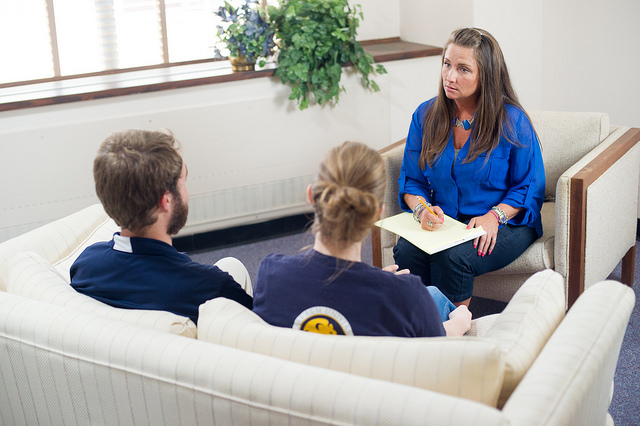Answers to Questions Asked by Training Therapists
Here I share with you the reference booklet put together by Zeynep Arslan, a graduate student in Clinical Psychology in Sarajevo International University, as part of her internship program:
The Therapist’s Reference Book
About a month ago, when I closed my eyes to imagine my first session with my first client, I kept finding myself in an immense chaos. My worries about being a good therapist increased with questions such as “How shall I start? What will be their first impression of me? When do I need to be more active during the session? What if I make a mistake?” and so on. Although I had acquired the skills necessary to work as a therapist –at least in theory– this did not help alleviate my doubts.
I felt the fact that I studied in another language than my mother tongue in university might have prevented me from fully absorbing some important information.
I needed something, or someone, to help me minimize my concerns before starting to practice my profession. The best person to understand this confusion and support me could only be an experienced therapist. That is how I approached dear Irem Bray. I find the interview we did with her would be helpful for my colleagues who have similar hardships as me.
- Do I need to prepare beforehand for each session?
We must make sure we start each session knowing what the client has been talking about in previous sessions, their family tree, childhood traumas, and the difficulties they experience in communication. These details will not only help us evaluate the issues brought into the current session better but also will make our clients feel that we value them and that they are special for us.
In the early years of your career, thinking about structuring the session beforehand, ie. thinking about and planning the issues we shall deal with during the session and the ways to handle them, might help us feel more confident as therapists. However as we progress we may feel that some of these preparations do not prove especially helpful, or even obstruct the process. We may miss valuable spontaneous input from the part of our client while trying to apply our own plan. This is because many events come to pass in our client’s life in between sessions and our plan may not always coincide with their current priorities.
Our starting point should always be what the client brings. In subsequent sessions we may notice issues they tend to avoid and we may have to consider what they do not bring into the discussion. Yet, generally speaking, bringing up a topic mentioned in the previous session might freshen up the connection and help the client relax. This might deepen their trust in us and help them share more intimate material. Therefore I feel it’s important to refrain (as much as possible) from imposing too much structure into the session to nurture the special connection between the therapist and the client, that we call intersubjectivity, and to make room for what wants to come out.
So it’s best to go along with the session and use our preparation when we need an alternative. I find the Gestalt approach that emphasizes “here and now” a meaningful and useful feature while managing sessions. In general, we feel better as therapists when we refrain from interfering in the natural flow between us and the client to immerse ourselves into what the session brings.
- How can I work with clients whose opinions and world view disagree with mine? For instance, when their sexual orientation or religious life is different from mine, what stance should I adopt?
The very first thing we have to remember in such situations is that the person we face is a human being. We have to emphasize the awareness that, when we set aside political, socio-cultural or religious views, we have much in common, such as our need to love and be loved, to bond, to express our needs and to have our needs met. At this level, all people are equal. Although we may feel different from one another in social and cultural contexts, we see our differences are superficial when we can adopt a human nature perspective.
We all evolve in interaction with our surroundings; we don’t know who we would have become had we been raised in the other person’s living conditions. What makes us practitioners of this profession is our ability to view every situation as a manifestation of human nature, without judging. Under the same conditions as them, we might have experienced the same problems. When we look at it this way, we see that the other person is no different from us, they are just a fellow human being with different experiences, who needs our help right now. We have things to learn from them, as they from us. Therefore, if we can adopt a learning attitude and approach them with a desire to understand the reasons that cause them to think and act as they do, it doesn’t matter whether their views agree with us or not.
I always assume a consultant and a therapist who have met in a therapeutic environment have things to learn from eachother. Naturally, they both bring values and beliefs from their respective histories to the encounter. It is the therapist’s duty to approach these with awareness.
Let’s say, you wear the hijab and your Muslim identity stands out. When you talk about the negative effects of alcohol on the brain and relationships to a consultant who drinks, they may perceive it as coming from a religious perspective. One way to prevent prejudices from reflecting negatively on the therapeutic relationship and the process is to voice them, for example you might give the following explanation: “Maybe you think I’m against alcohol because of my religious beliefs, but this is not true. I’m aware that this is a totally personal choice, yet because of my position as a therapist, it’s my responsibility to point out that alcohol has negative effects on your life and relationships.”
- How can I tell whether my emotional reaction stems from empathy or an uncontrolled expression of my own scars?
First of all, in any of our sessions we must never forget that our identity as a human being comes before our professional identity. Putting our professional identity before our humanity would reduce us to technicians. We should be able to cry when we are sad and to show it when we are happy.
We know that the most important healing factor in therapy is the relationship between the therapist and the consultant. An honest, sincere relationship… We have to establish a real relationship to make our consultant feel valued as a human being. We should know that our emotions help us as therapists. Although the degree of expression of feelings and emotions vary among therapeutic approaches, we need to be aware of our own emotions in order to be a sound and effective therapist. That’s why we see that good therapists have all experienced individual therapy.
Of course that doesn’t mean we should sob and sigh with our consultant but we may allow a teardrop or two to roll down our face. It might help to remember that our responsibility in therapy is to understand our consultant and help them find a way out of their troubles in life, so we can maintain a solution oriented stance in the face of their problems.
- How should I start the session?
I recommend starting the session by talking about non-problematic topics instead of embarking directly upon the problems of the consultant. In fact, if they start talking about the problem right at the beginning of the session, I stop them and talk about some other topic, thus making them feel that I am in charge of the session while preventing the problem to dominate the entirety of the therapy environment.
- How should I steer the therapy?
In our sessions, we should always focus on understanding our consultant. We first have to “join” them, which means to communicate that we understand them without judging or criticizing. We and our consultant meet and become one.
Then, we need to lead them. At this stage, because a feeling of trust has been established between us, they will be more open to our guidance. That’s what I mean by leading. When leading, we may say things like “This should not be accepted, the consequences may be such and such…” The important point is to leave the choice to the consultant. They are the ones to make their own choices, in time, we will just be talking about the pros and cons of each decision.
In brief, the therapy process starts with joining, that is, understanding the consultant, then we go on to facilitate their making different choices and trying different solutions within the safety of the therapeutic environment/relationship. Our stance should be one of authority and guidance; we should display a supportive, accepting and non-judgmental attitude that encourages self-discovery without pushing or forcing.
- When should I interrupt my consultant to ask questions, and how?
As I said in the answer to the last question, we must listen to the consultant and try to understand them. Of course, we cannot help them solve their problems just by listening. We need to ask questions that will affect the process and create awareness in the consultant.
For instance; a helpful phrase might be: “As you may have noticed, you keep repeating yourself in every session. If you continue to think and act like you always have been, you will end up getting the same results, that’s why I’m stopping you.”
To induce change and awareness in a patient who tends to blame others for their problems, you may use a solution oriented sentence after letting them express themselves, such as: “I see you feel really tired and helpless in the face of these problems. So what can you change in yourself to overcome these issues and what effect would these changes create? Let us think together.”
- What distance should I keep from the consultant?
The therapy process takes place in an environment of trust instituted through privacy and expertise, where intimate issues are discussed. Distance is very important in this relationship. Many of the consultants experience problems arising from their inability to establish healthy boundaries. Therefore we provide a good role model by displaying a firm and clear attitude.
Starting and ending sessions on time and having clear rules help establish and maintain the distance. Ethical codes discourage the therapist from seeing the consultant in social occasions, however we may encounter exceptional situations. I recommend you bring these forward during supervision in order to examine and evaluate the issue in full detail.
Even though we should never consider our consultants as potential friends or companions, I believe we have to be able to approach the situation with an openness to learn when life brings us together in different settings. Sometimes, breaches that happen in spite of our efforts may constitute turning points in the consultant’s progress towards overcoming their issues.
With some consultants, being on a first-name basis may help them relax and express themselves more easily as it conforms to their cultural codes. Also, giving examples from real life, our own life and circle, or our other consultants (without violating their rights of privacy) may make it easier to increase awareness and help the consultant absorb the message.
Distance takes on a whole new meaning in sessions held with more than one person, such as family sessions. In such situations, it’s an important skill to keep the same distance to each of the people present.
- How can I interpret the consultant’s non-verbal signals?
So much happens both to us and to our consultant when we start the session! While we listen to what they have to say and try to understand it with an accepting disposition, we also try to come up with something that will help them heal and move forward.
To do this, we have to step aside, let go of our own worries and problems of the day, and focus fully on our consultant.
Therefore, during this process we have to observe the consultant’s posture, gaze, gestures, and movements carefully. Sometimes the consultant will move forward in their seat. This may mean they want to be heard or they are telling something confidential. Or they will have a telling facial expression while they talk, they will seem to struggle to refrain from telling more. We need to interpret these signs correctly. We can point them out during the session or keep it to ourselves as a piece of observed information.
While sometimes the signs are quite dramatic, at other times you will have to notice nuances. Some of these may be voiced or displayed consciously, some unawares. For instance, you may interrupt a consultant talking angrily and ask them to repeat what they’ve just said calmly. They may say, “But I wasn’t talking angrily!” which shows either that they are not aware of their anger or that the anger is there although they consciously deny it. We may make it easier for them to understand their emotions and show them that we accept them by saying: “Either you are not aware of your anger or you don’t feel you could say this calmly at the moment.”
To give another example, we might say “I can see your anger in your look and your words,” to an angry consultant. If they say they are not angry at all, we may try and work with them to understand their relationship with this emotion by asking: “How was anger received in your family? Is it an emotion that makes you anxious?” and so on. We have to have the consultant notice the discrepancy between their words and body language kindly and without engaging in conflict.
- Which method of therapy should I adopt?
The systemic approach is like an umbrella. It acts as filter while we observe what is happening during the session. Each therapy approach brings different benefits to us and to the therapy. They enrich our perception and increase our resources. It would be best to integrate all techniques instead of limiting ourselves to a single therapy method, and to adopt an approach suitable for the consultant. This enhances our perceptivity and helps us view the situation from many different perspectives. This broadens our understanding. There is no harm in using an integrated technique as long as we can explain why we use each method to ourselves. Besides, all available techniques increase the number of alternative interventions we can use.
- When should I use the confrontation technique?
Confrontation is too strong a word. To me, this technique is a process of creating awareness. It comes into the picture when you intuitively feel that the consultant is ready to take a different perspective.
Before using this technique you must be sure that the consultant feels understood and accepted. We first need to join our consultant to understand them. I find it very important to have a cyclical awareness of the processes in order to create awareness in our consultants. That means avoiding blame and judgment, and emphasizing interaction and communication, such as this sentence: “Both mother and child are nervous and edgy in the morning when they have not been able to get enough sleep; the child is slow to get dressed and fusses over breakfast, the mother gets angry and yells, the child doesn’t want to go to school.”
Because, pointing out one’s shortcomings in a critical and judgmental manner creates embarrassment and anger. When people feel this way they shut themselves to change and become defensive. We must keep that in mind when we aim to increase awareness.
- Should I give therapy to acquaintances? How should my relationship be with my friends and relatives during therapy?
It’s not appropriate to give therapy to very close friends or relatives because the different definitions of the relationship create confusion and make it difficult to establish and maintain a therapeutic relationship.
In fact, it is not recommended to give therapy to people we see socially, for the same reason. However you may have to bend the rules at times when you are a therapist who lives and works in a small community, like I am. People are usually reluctant to go to a therapist they do not know personally, they want to work with me because they know and trust me, and when I refer them to another therapist they simply won’t go.
In such situations, I recommend you see the person in the therapy setting, so you can approach the matter professionally and thoroughly, rather than nonchalantly. We have to make it clear to the consultant first thing that this creates a risk for the relationship, because it may not be possible to remain friends after we start therapy. The content of the discussions between the therapist and the consultant during therapy may not proceed as expected or desired, and this may create anger toward the therapist, resulting in complete loss of the relationship for both parties. When taking such a decision you have to keep that in mind and know that this is a real risk.
- How should we maintain confidentiality?
Confidentiality means everyone we work with is fully aware of consultant privacy rights. Our colleagues will be just as conscious as we are about this principle but people such as your assistant or accountant need to be explicitly told about the principle of confidentiality. I have always made it clear I am very sensitive to confidentiality and view it as a necessary condition for working together.
What is discussed during the sessions must not leave the room. We can only share it with our supervisor or colleagues. It is not ethical to share our consultant’s private matters with our partner or friends. Besides, we should refrain from sharing details of our cases in order to protect our loved ones because some of the cases we encounter may be really sad and traumatize people who are not professionals.
I believe it’s best to get supervision or peer support when working on such cases to protect ourselves.
- How should I take the comments of the consultants?
We can get very positive or very negative comments from our consultants. We have to be able to remain neutral in the face of both. We must evaluate all comments within the context of the therapeutic relationship rather than personally.
We can get positive comments in situations where the consultant idealizes the therapist, and negative comments when they reflect their inner aggression upon us.
We have to emphasize that positive references are strong motivations. Every word of the therapist bears a meaning for the consultant. Therefore we have to be careful with our own comments so that idealizations do not turn into aggression or persecution anxiety. Or we should carry out the therapy process under supervision and in a controlled manner.
We should point out the consultant’s emotions underlying their positive or negative comments. For instance, we can verbalize their emotions with a phrase such as: “Yes, I understand that you feel very angry towards me.” We have to be able to remain neutral at all times as the therapist.
- What should I make of the consultants’ not showing up for sessions?
Every word and act of the consultant is a piece of communication. Likewise, not showing up for a session carries a meaning both from the point of view of the therapist-consultant relationship and the point of view of the consultant’s life. I find it important to maintain a curious and inquiring attitude in order to discover these meanings.
I consider supervision necessary especially for new therapists, so they can protect themselves and acquire the competence necessary for the practice. In later stages, the need for supervision still remains, yet under a different form. Supervision is very important for us to develop self awareness and to think about and understand the process thoroughly.
When your consultant doesn’t show up for the session, it may be due to many different reasons; they may have forgotten because they have a chaotic life, it may be their way of protesting because their family is labeling them for receiving therapy, or they may not have the money to pay for the session. If this makes you feel let down, rejected, inadequate or unsuccessful, you have to discuss the issue with your supervisor and try and evaluate the process to understand the interaction between you and your consultant. When your consultant doesn’t show up this doesn’t mean you have failed; but it would be a failure to call it a “drop out” straight away, to take the full responsibility and bottle it up.
- What should I make of it when a consultant doesn’t achieve any change?
It has been said by many different philosophers throughout history that change is the only constant. Even though we might not notice, our consultants can not remain unchanged due to many factors including our sessions, our talking over their issues, or our witnessing their processes. The reason we fail to notice it may be our being too focused on the problem or the consultant’s not showing us the change their going through. Or our expectations may be so high that we underestimate the change we see.
Maybe I could talk about what you would feel in case the problem which caused the consultant to seek help persists. New therapist may experience performance anxiety and feelings of inadequacy especially when faced with anxious consultants who have a tendency to put the responsibility of change on the therapist.
As Western medicine objectifies illness and tends to use drugs to solve all health problems, the patients’ ability to take responsibility for their health is dwindling. Taking full responsibility for change and thinking we are the only one to blame for failure is unrealistic and will eventually lead to burnout, so we are unable to practice.
In fact, the person who will bring about the change is the consultant themselves. Our sole responsibility is to show them their own potential, teach the methods they can use to create change, and provide a suitable environment to facilitate change. We have to maintain this stance right from the beginning and we should be able to show the consultant bravely that they need to put in more effort.
- Should we seek to diagnose our patients’ problems and should we tell them the diagnosis?
As our job is based on talking, our choice of words is very important. Both the concepts of patient and diagnosis are medical terms. When we make a diagnosis we are telling the consultant that their problems fit the criteria in the DSM (Diagnostic and Statistical Manual of Mental Disorders) sufficiently. When we use terms such as patient and diagnosis, we are accepting the underlying assumptions and the therapeutic system takes shape around this decision.
Whether you will make a diagnosis or not depends on the kind of problem, the family dynamics, and the therapy model adopted. In fact, I prefer to use the term consultant instead of patient except very rarely, because the terms patient and illness are associated with a model which relies on drugs and puts the responsibility of healing on the therapist.
Of course there are always exceptions. For instance, when faced with a life threatening disorder such as anorexia it’s an important part of the therapy to name it and to point out the fatal risk.
If the consultant comes to us with a previous diagnosis and a history of therapy, we have to work with those. In some family systems where the difficulties of the individual are normalized and ignored, diagnoses can be used as a tool to shake the system out of balance and induce action.
Lastly, you have, at the beginning of the interview, mentioned the challenges of receiving education or training in a foreign language. I would like to add a few things about that. A foreign language leads us to go outside the boundaries of our native culture and think with other words, other concepts. This helps us overcome our conditioning and become a better therapist. Therefore I think the challenges you experienced were very productive and helpful for you professionally.
I hope this interview helps you and other beginner therapists like yourself.
Please share your thoughts, experiences, questions and feedback in the Comments section below. I read and reply to each of them.
You can listen to the soundtrack of this video from here.





